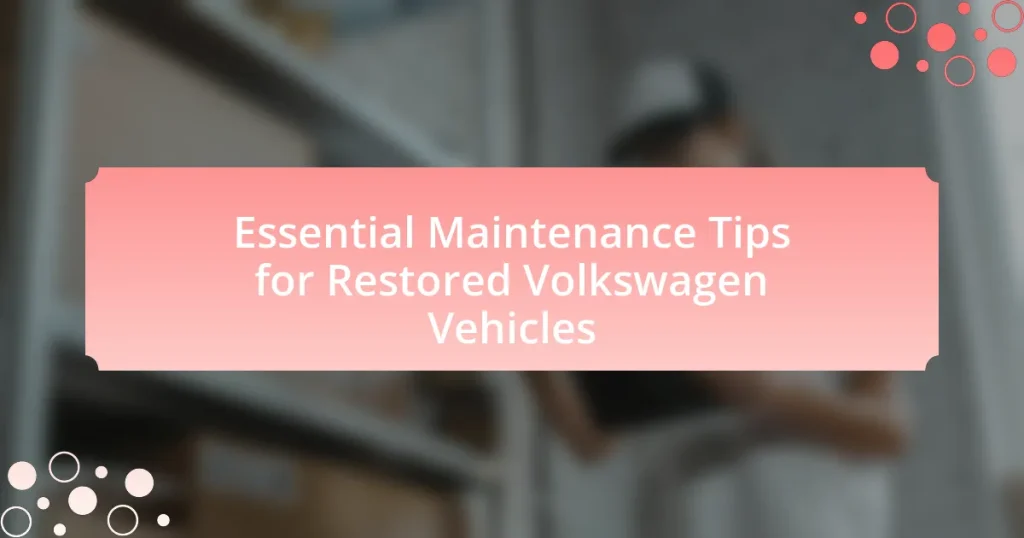Essential maintenance tips for restored Volkswagen vehicles focus on key practices that ensure longevity and optimal performance. Regular oil changes, tire pressure checks, brake inspections, and fluid level monitoring are critical to prevent mechanical failures and enhance safety. The article emphasizes the importance of routine maintenance to identify potential issues early, thereby preserving the integrity of restoration work. It also outlines specific maintenance areas, including the engine, transmission, brakes, suspension, and electrical systems, while providing practical advice on tools, supplies, and common mistakes to avoid. Overall, consistent upkeep is essential for maximizing the lifespan and driving enjoyment of these classic vehicles.

What are Essential Maintenance Tips for Restored Volkswagen Vehicles?
Essential maintenance tips for restored Volkswagen vehicles include regular oil changes, checking and maintaining tire pressure, inspecting brakes, and ensuring proper fluid levels. Regular oil changes are crucial as they keep the engine lubricated and functioning efficiently, typically recommended every 3,000 to 5,000 miles. Maintaining tire pressure is important for safety and fuel efficiency, with the ideal pressure usually found in the owner’s manual. Brake inspections should be conducted frequently to ensure safety, as worn brake pads can lead to decreased stopping power. Additionally, checking fluid levels, including coolant, brake fluid, and transmission fluid, helps prevent overheating and mechanical failures, ensuring the vehicle operates smoothly.
Why is regular maintenance important for restored Volkswagen vehicles?
Regular maintenance is crucial for restored Volkswagen vehicles to ensure their longevity and optimal performance. This maintenance helps identify and address potential issues before they escalate, preserving the integrity of the restoration work. For instance, regular oil changes, brake inspections, and fluid checks can prevent engine wear and enhance safety, which is particularly important given that older models may have unique vulnerabilities. Additionally, maintaining proper tire pressure and alignment can improve fuel efficiency and handling, which are essential for a smooth driving experience. Overall, consistent upkeep not only protects the investment made in restoration but also enhances the driving enjoyment of these classic vehicles.
What specific issues can arise from neglecting maintenance?
Neglecting maintenance can lead to significant issues such as mechanical failures, decreased performance, and increased repair costs. For instance, failing to regularly check and change engine oil can result in engine wear and potential failure, as dirty oil loses its lubricating properties over time. Additionally, neglecting tire maintenance can lead to uneven wear, reduced fuel efficiency, and compromised safety due to blowouts. Statistics indicate that regular maintenance can extend vehicle lifespan by up to 50%, highlighting the importance of consistent care to avoid these detrimental outcomes.
How does maintenance impact the longevity of restored vehicles?
Maintenance significantly enhances the longevity of restored vehicles by ensuring that all components function optimally and preventing deterioration. Regular maintenance activities, such as oil changes, fluid checks, and inspections of critical systems, help identify and address potential issues before they escalate into major problems. For instance, a study by the Automotive Maintenance and Repair Association indicates that vehicles receiving consistent maintenance can last up to 50% longer than those that are neglected. This demonstrates that proactive care not only preserves the vehicle’s performance but also extends its lifespan, making maintenance a crucial factor in the longevity of restored vehicles.
What are the key maintenance areas for restored Volkswagen vehicles?
The key maintenance areas for restored Volkswagen vehicles include the engine, transmission, brakes, suspension, and electrical systems. Regularly checking and maintaining the engine ensures optimal performance and longevity, as these vehicles often have vintage components that require specific care. The transmission should be inspected for fluid levels and leaks to prevent costly repairs. Brake systems must be evaluated for wear and functionality to ensure safety, while the suspension components should be assessed for wear to maintain ride quality. Lastly, the electrical systems, including wiring and battery condition, should be routinely checked to prevent failures, as older vehicles may have outdated electrical components that are prone to issues.
How should the engine be maintained in a restored Volkswagen?
To maintain the engine in a restored Volkswagen, regular oil changes using high-quality oil are essential to ensure proper lubrication and prevent wear. Additionally, checking and replacing the air filter, fuel filter, and spark plugs at recommended intervals will enhance engine performance and efficiency. Regularly inspecting the cooling system, including the radiator and hoses, is crucial to prevent overheating, while ensuring that the ignition system is functioning correctly will optimize fuel combustion. These maintenance practices are supported by the Volkswagen service manuals, which emphasize the importance of routine checks to prolong engine life and reliability.
What steps are necessary for proper transmission care?
To ensure proper transmission care, regularly check and change the transmission fluid according to the manufacturer’s recommendations. This step is crucial because clean fluid lubricates the transmission components, preventing wear and overheating. Additionally, inspect the transmission filter for clogs and replace it as needed to maintain optimal fluid flow. Regularly monitoring for leaks and addressing any issues promptly will also help preserve the transmission’s integrity. Following these steps can significantly extend the lifespan of the transmission in restored Volkswagen vehicles.
How can one ensure the electrical system is functioning optimally?
To ensure the electrical system is functioning optimally, regularly inspect and maintain all electrical components, including wiring, fuses, and connections. This proactive approach prevents issues such as corrosion, loose connections, and worn-out parts, which can lead to system failures. For instance, according to the National Highway Traffic Safety Administration, regular maintenance can reduce the risk of electrical failures by up to 30%. Additionally, using a multimeter to check voltage levels and continuity can help identify potential problems before they escalate.
What tools and supplies are essential for maintaining restored Volkswagen vehicles?
Essential tools and supplies for maintaining restored Volkswagen vehicles include a comprehensive toolset, oil and filters, cleaning supplies, and replacement parts. A comprehensive toolset typically consists of wrenches, screwdrivers, pliers, and sockets specifically designed for Volkswagen models, ensuring proper fit and function. Regular oil changes require high-quality engine oil and filters tailored to the specific engine type, which is crucial for optimal performance and longevity. Cleaning supplies, such as car wash soap, wax, and microfiber cloths, help maintain the vehicle’s exterior and interior aesthetics. Additionally, having access to replacement parts, including brake pads, belts, and hoses, is vital for addressing wear and tear, ensuring the vehicle remains in excellent condition. These tools and supplies are essential for effective maintenance and preservation of restored Volkswagen vehicles.
What basic tools should every Volkswagen owner have?
Every Volkswagen owner should have a basic toolkit that includes a socket set, screwdrivers, pliers, a torque wrench, and a jack. A socket set is essential for various bolt sizes found in Volkswagen vehicles, while screwdrivers are necessary for interior and exterior components. Pliers assist in gripping and manipulating wires and hoses. A torque wrench ensures that bolts are tightened to the manufacturer’s specifications, which is crucial for safety and performance. Lastly, a jack is needed for lifting the vehicle for tire changes or undercarriage inspections. These tools are fundamental for routine maintenance and repairs, ensuring that Volkswagen owners can effectively manage their vehicle’s upkeep.
Which maintenance supplies are crucial for routine checks?
Crucial maintenance supplies for routine checks of restored Volkswagen vehicles include engine oil, oil filters, air filters, brake fluid, coolant, and tire pressure gauges. Engine oil is essential for lubrication and performance, while oil filters ensure contaminants are removed from the oil system. Air filters maintain optimal air intake for combustion efficiency. Brake fluid is vital for the braking system’s functionality, and coolant prevents overheating. Tire pressure gauges are necessary for maintaining proper tire inflation, which affects safety and fuel efficiency. Regular checks of these supplies help ensure the vehicle operates smoothly and safely.
How can owners identify maintenance needs in their restored Volkswagen vehicles?
Owners can identify maintenance needs in their restored Volkswagen vehicles by conducting regular inspections and monitoring performance indicators. Regularly checking fluid levels, tire condition, and brake functionality helps in early detection of potential issues. Additionally, owners should refer to the vehicle’s service manual for recommended maintenance schedules and specific checks relevant to their model. Keeping a maintenance log can also assist in tracking repairs and identifying recurring problems, ensuring that all necessary upkeep is addressed promptly.
What signs indicate that a vehicle requires immediate attention?
Signs that indicate a vehicle requires immediate attention include warning lights on the dashboard, unusual noises from the engine or brakes, fluid leaks under the vehicle, and a significant drop in performance or handling. For instance, a check engine light can signal various issues, from minor to severe, necessitating prompt diagnostics. Unusual noises, such as grinding or squeaking, often indicate problems with brakes or other critical components. Fluid leaks, such as oil or coolant, can lead to engine overheating or damage if not addressed quickly. Lastly, a noticeable decline in performance, such as difficulty accelerating or steering, can indicate serious mechanical issues that require immediate inspection.
How can regular inspections prevent larger issues?
Regular inspections can prevent larger issues by identifying potential problems early before they escalate. For instance, routine checks on a restored Volkswagen vehicle can reveal wear and tear on critical components such as brakes, tires, and engine parts. According to the National Highway Traffic Safety Administration, regular vehicle maintenance can reduce the likelihood of breakdowns by up to 50%. By addressing minor issues during inspections, vehicle owners can avoid costly repairs and ensure safety on the road.

What specific maintenance practices should be followed for restored Volkswagen vehicles?
Restored Volkswagen vehicles should undergo regular inspections, fluid changes, and component checks to ensure optimal performance. Regular inspections should include checking the engine, transmission, brakes, and suspension systems for wear and tear. Fluid changes, particularly for oil, coolant, and brake fluid, should be performed according to the manufacturer’s recommendations to maintain engine health and performance. Additionally, components such as belts, hoses, and tires should be inspected and replaced as necessary to prevent breakdowns. Following these practices helps maintain the vehicle’s reliability and longevity, as evidenced by the fact that regular maintenance can extend the lifespan of classic cars significantly, often by several decades.
How often should oil changes be performed on restored Volkswagen vehicles?
Oil changes should be performed every 3,000 to 5,000 miles on restored Volkswagen vehicles. This frequency ensures optimal engine performance and longevity, particularly for older models that may have different tolerances and wear characteristics compared to modern vehicles. Regular oil changes help maintain proper lubrication, reduce engine wear, and prevent sludge buildup, which is crucial for the health of restored engines.
What type of oil is best for restored Volkswagen engines?
The best type of oil for restored Volkswagen engines is a high-quality synthetic oil with a viscosity rating of 10W-40. This oil type provides excellent protection and performance, particularly in older engines that may have looser tolerances. Synthetic oils are known for their superior thermal stability and resistance to breakdown, which is crucial for maintaining engine health in restored vehicles. Additionally, using oil that meets or exceeds API (American Petroleum Institute) specifications ensures compatibility with the engine’s materials and seals, further enhancing longevity and performance.
How can one check oil levels and quality effectively?
To check oil levels and quality effectively, one should first ensure the vehicle is on a level surface and the engine is off for at least 10 minutes. Next, remove the dipstick, wipe it clean, reinsert it fully, and then remove it again to observe the oil level against the marked indicators. For quality assessment, examine the oil’s color and consistency; clean oil is typically amber, while dark or gritty oil indicates contamination or degradation. Additionally, a smell of burnt oil suggests it needs changing. Regular checks, ideally every 1,000 miles or monthly, help maintain optimal engine performance and longevity.
What is the best way to maintain the brakes on restored Volkswagen vehicles?
The best way to maintain the brakes on restored Volkswagen vehicles is to regularly inspect and replace brake components as needed, including pads, rotors, and fluid. Regular inspections should occur every 6,000 miles or at least once a year, focusing on checking for wear and tear, ensuring proper fluid levels, and looking for leaks. Additionally, using high-quality brake fluid that meets Volkswagen specifications is crucial, as it helps maintain braking efficiency and prevents moisture absorption, which can lead to corrosion. Proper maintenance not only enhances safety but also prolongs the lifespan of the braking system, ensuring optimal performance in restored Volkswagen vehicles.
How can one tell when brake pads need replacing?
Brake pads need replacing when they exhibit significant wear, typically indicated by a thickness of less than 3 millimeters. Additionally, audible signs such as squeaking or grinding noises during braking often signal that the pads are worn down. According to the Automotive Service Association, regular inspections should be conducted every 12,000 miles or as recommended by the vehicle manufacturer to ensure optimal braking performance and safety.
What are the steps for checking brake fluid levels?
To check brake fluid levels, first locate the brake fluid reservoir, which is typically found near the back of the engine bay, close to the driver’s side. Next, inspect the reservoir’s fluid level against the marked indicators on the side; the fluid should be between the “MIN” and “MAX” lines. If the level is below the “MIN” line, add the appropriate brake fluid type as specified in the vehicle’s manual. Finally, securely close the reservoir cap to prevent contamination. Regular checks are essential, as low brake fluid can indicate leaks or other issues in the braking system.
How should tires be cared for on restored Volkswagen vehicles?
Tires on restored Volkswagen vehicles should be regularly inspected for wear, properly inflated to the manufacturer’s recommended pressure, and rotated every 5,000 to 7,500 miles to ensure even tread wear. Regular inspections help identify any damage or irregularities, while maintaining the correct tire pressure enhances fuel efficiency and handling. Rotating tires prevents uneven wear, extending their lifespan. According to the Tire Industry Association, proper tire maintenance can increase tire life by up to 30%.
What tire pressure is recommended for different Volkswagen models?
The recommended tire pressure for different Volkswagen models typically ranges from 30 to 35 PSI (pounds per square inch). For example, the Volkswagen Golf usually requires 32 PSI, while the Volkswagen Jetta often recommends 30 PSI. These specifications can vary slightly based on the model year and specific trim, but the general guideline remains consistent across most models. It is essential to check the vehicle’s owner manual or the tire placard located on the driver’s side door jamb for the exact recommended tire pressure for a specific Volkswagen model.
How can tread wear be monitored effectively?
Tread wear can be monitored effectively by using a tread depth gauge, which provides precise measurements of the tire tread depth. Regularly checking the tread depth is crucial, as tires with insufficient tread can lead to reduced traction and increased risk of hydroplaning. According to the National Highway Traffic Safety Administration, tires should have at least 2/32 of an inch of tread depth for safe performance. Additionally, visual inspections for uneven wear patterns can indicate alignment or inflation issues, allowing for timely maintenance.

What common mistakes should be avoided in maintaining restored Volkswagen vehicles?
Common mistakes to avoid in maintaining restored Volkswagen vehicles include neglecting regular maintenance checks, using incorrect fluids, and failing to address rust promptly. Regular maintenance checks are crucial as they help identify potential issues before they escalate; for instance, not checking the oil levels can lead to engine damage. Using incorrect fluids, such as non-VW approved oil or coolant, can compromise the vehicle’s performance and longevity. Additionally, rust should be addressed immediately, as it can spread and cause structural damage; according to the Classic Car Restoration Club, untreated rust can significantly decrease a vehicle’s value and safety.
What are the pitfalls of using incorrect parts in maintenance?
Using incorrect parts in maintenance can lead to significant operational failures and safety hazards. When parts do not meet the specifications required for a vehicle, such as those found in restored Volkswagen models, they can cause mechanical malfunctions, reduced performance, and increased wear on other components. For instance, using a non-compatible brake pad can lead to decreased braking efficiency, which poses a safety risk. Additionally, incorrect parts may void warranties or insurance claims, as manufacturers often require the use of OEM (Original Equipment Manufacturer) parts for coverage. This underscores the importance of ensuring that all replacement parts are specifically designed for the vehicle model to maintain safety, performance, and warranty compliance.
How can using non-OEM parts affect vehicle performance?
Using non-OEM parts can negatively affect vehicle performance by compromising fit, reliability, and overall functionality. Non-OEM parts may not meet the same quality standards as original equipment manufacturer (OEM) components, leading to issues such as poor fitment, reduced efficiency, and increased wear on other vehicle systems. For example, a study by the Automotive Aftermarket Industry Association indicates that non-OEM parts can lead to a 20% higher failure rate compared to OEM parts, which can ultimately result in decreased vehicle performance and safety.
What are the risks of ignoring manufacturer recommendations?
Ignoring manufacturer recommendations can lead to significant risks, including safety hazards, decreased vehicle performance, and increased repair costs. For instance, neglecting recommended maintenance schedules can result in engine failure or brake system malfunctions, which pose safety risks to the driver and others on the road. Additionally, failure to adhere to guidelines may void warranties, leading to out-of-pocket expenses for repairs that would have otherwise been covered. According to a study by the Automotive Service Association, vehicles that receive regular maintenance as per manufacturer guidelines can last up to 50% longer than those that do not. This highlights the importance of following manufacturer recommendations to ensure vehicle longevity and safety.
How can improper maintenance practices lead to costly repairs?
Improper maintenance practices can lead to costly repairs by allowing minor issues to escalate into major problems. For example, neglecting regular oil changes can result in engine wear and tear, ultimately requiring a complete engine rebuild, which can cost thousands of dollars. Additionally, failing to address brake wear can lead to brake failure, posing safety risks and necessitating expensive repairs. According to the Automotive Maintenance and Repair Association, routine maintenance can reduce repair costs by up to 50%, highlighting the financial impact of neglecting proper care.
What are the long-term effects of neglecting routine checks?
Neglecting routine checks on restored Volkswagen vehicles can lead to significant long-term effects, including decreased vehicle performance, increased repair costs, and potential safety hazards. Over time, the lack of regular inspections can result in unnoticed wear and tear on critical components such as the engine, brakes, and suspension, which may lead to catastrophic failures. For instance, a study by the National Highway Traffic Safety Administration indicates that regular vehicle maintenance can reduce the likelihood of accidents caused by mechanical failure by up to 50%. Additionally, failure to address minor issues during routine checks can escalate into major repairs, costing vehicle owners significantly more in the long run.
How can one avoid common maintenance oversights?
To avoid common maintenance oversights, one should implement a systematic maintenance schedule that includes regular inspections and servicing of key vehicle components. This proactive approach ensures that issues are identified early, reducing the risk of more significant problems later. For instance, according to the Automotive Maintenance and Repair Association, regular oil changes and fluid checks can extend the lifespan of a vehicle and enhance performance. Additionally, utilizing a checklist for routine maintenance tasks can help ensure that no critical areas are overlooked, such as tire pressure, brake functionality, and electrical systems.
What practical tips can help ensure effective maintenance of restored Volkswagen vehicles?
To ensure effective maintenance of restored Volkswagen vehicles, regular inspections and servicing are essential. Owners should perform routine checks on the engine, brakes, and suspension systems to identify any potential issues early. Additionally, maintaining proper fluid levels, including oil, coolant, and brake fluid, is crucial for optimal performance. Using high-quality parts and fluids specifically designed for Volkswagen models can enhance reliability and longevity. Furthermore, storing the vehicle in a climate-controlled environment helps prevent rust and deterioration, which is particularly important for classic models. Regularly washing and waxing the exterior protects the paint and body from environmental damage. These practices are supported by the fact that regular maintenance significantly reduces the likelihood of costly repairs and extends the lifespan of the vehicle.
How can a maintenance schedule be effectively created and followed?
A maintenance schedule can be effectively created and followed by first identifying the specific maintenance needs of restored Volkswagen vehicles, which typically include regular oil changes, brake inspections, and tire rotations. Next, one should establish a timeline for these tasks, such as monthly, quarterly, or annually, based on the vehicle’s usage and manufacturer recommendations. Utilizing a digital calendar or maintenance tracking app can help in setting reminders and logging completed tasks. Additionally, documenting each maintenance activity with dates and details ensures accountability and helps in tracking the vehicle’s performance over time. Following this structured approach not only enhances the vehicle’s longevity but also ensures compliance with warranty requirements and safety standards.
What resources are available for Volkswagen owners seeking maintenance guidance?
Volkswagen owners seeking maintenance guidance can access several resources, including the official Volkswagen website, which offers detailed maintenance schedules and service manuals. Additionally, Volkswagen’s mobile app provides reminders for service appointments and access to vehicle information. Online forums and communities, such as VWVortex and TheSamba, also serve as platforms for owners to share experiences and advice. Furthermore, authorized Volkswagen dealerships provide professional maintenance services and expert guidance tailored to specific models. These resources collectively ensure that Volkswagen owners have comprehensive support for maintaining their vehicles effectively.


